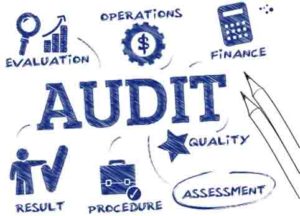SEO Audit
An audit is the analysis of the website based on its insights, web pages and traffic. Using these analyses we can check out how the website is performing on the search engine result pages (SERP). In this blog, we are going to check out some of the SEO audit recommendations and checklists.
Audit process
We are now going to see about how we are going to go at the audit process. There are 11 important steps that are recommended for an audit process.
- Objective.
- Domain authority.
- Keyword analysis.
- Competitor analysis.
- Technical analysis.
- Page-level analysis.
- Content analysis.
- User experience analysis.
- Link analysis.
- Citation analysis.
- Social media analysis.
Objective
The objective of an SEO audit is solely going to be on how to increase the business. In order to do that you need to analyse all the insights of the website, where the website is lagging and what are the improvements that needs to be done at that particular department. The objective differs for different businesses, certain websites need to improve the speed, some of them need to optimize the links in their website and some might have a poor domain authority. An audit should be able to perform all of these technical aspects and correct them.
Domain authority
Domain authority is a measure of the power of the domain name and it is an important search engine factor. It is determined by the score given by moz, this score is used to predict how well the website is doing in the search engine result pages (SERP). The score ranges from 0-100, it is determined by various factors. The age of the domain name is a very important factor, when you start a website it is always good to have domain names which have a higher age this will help the website in its ranking. The history of the domain should also be closely studied, when you buy a domain you have to make sure that there are not any black marks present as it directly affects your new website. The number of links which leads to your website and also the number of links which leads to quality websites from your website are also a great factor to determine the score.
The domain authority score was first developed by moz.com, it was used to score the website on their current ranking position. When developments are given to the website the domain authority increases which increases its SERP ranking. The biggest advantage of domain authority is that it can be used to compare the DA score of the competitor website and by using some of the tools you can learn what are the changes that need to be done to increase your DA score. There is also something called as page authority(PA), which is used to give out the score for the particular page of the website.
Keyword analysis
Keywords analysis is the process of finding out the best keywords to bring out customers to your website through organic and paid search. Keyword analysis are necessary in the sense as they are used to bring out conversions by understanding what the customer wants and using that phrase in the search. It is also used to find out ways of how to beat the competitors and lay dominance in that particular keyword. There are many great advantages in keyword analysis, like optimizing the amount you spend on keywords. By using keyword analysis you can find out keywords which give out the maximum conversions and also the keywords which are wasteful. The keywords which are wasteful can be eliminated. It is also used to find new markets, prioritize your time by improving the best keywords etc. The only problem with keyword analysis is that it is time consuming, but there are tools which can be used to get the best keywords easily. Some of the keyword analysis tools are Google keyword planner, sem rush, moz
keyword explorer etc.
Competitor analysis
As the name suggests it is a process in which you identify your competitors and analyse their strengths they have over you and also where you are reigning above them. There are many tools which can be used to find out how your competitors are doing like spyfu, similar web etc. These tools can help find the number of backlinks the competitor has, check out their keyword density, see if their content is plagiarised, where you can try to put out your links etc. You can do the similar for your website and see where you are lagging and can correct them. This is a two way street, even your competitors can do the same thing for you and that is inevitable.
Technical analysis
When you start an audit the technical aspect should be the first one to be looked at. It is used to find out whether the website is working or not, if there are any technical problems present on the website. They lay a foundation for all the other the things you do, if the technical aspect is bad then it completely affects the whole website. The technical aspects which needs to be taken care in a website are
- Speed– this is an important part of the technical aspect of the website. If the speed of the website is not optimized it forces the visitor to use the competitor website which affects the bounce rate also. The loading speed is different for websites of different fields, there are number of ways to optimize the speed of the website like reducing image sizes, using cdn, external hosting platforms etc.
- Redirect issues– if a page of the website has been taken down you should immediately give out the 301 or 302 redirect (301 for permanent redirect & 302 for temporary redirect). This is done because the user experience declines if the customer sees no page which would reduce our ranking.
- Canonical– a canonical tag is given at a webpage to deduce the duplicate content issues. This helps the webmaster while crawling the particular webpage.
- Robots.txt– robots.txt or robots exclusion protocol is used to communicate with the webcrawlers. This tag is given to the webpage that you don’t want to be crawled.
- Sitemap– it is the list of pages present in the website. This shows the direction of where the pages lead to and should be properly optimized. Optimizing a sitemap leads to better indexing and higher results.
- Duplicate metadata– the usage of duplicate metadata is conceptualized in different ways. This is the process of adding the same meta description as the others, this is particularly not minded by Google but it is a practice which is better not to be done.
- Page level duplicate content– duplicate content is using the same content of our page in different pages of the site. This will not be penalized but makes it difficult for Google to find out unique content of the site.
- 404 error– this code is used to indicate pages which are not present on the site or if the customer types the wrong URL or if the appropriate URL has not been applied.
- URL– Uniform resource locator or URL is very important as it is the name of your resource online. It is usually used as it is the text used to link your webpage.
- Broken links– as the name suggests the link leads directly to pages which have not been optimized like incorrect URL’s in the search, without updating the URL’s etc. This can be corrected by adding the 404 error code.
Page level analysis
Page-level analysis is otherwise known as ON page analysis is done to specific webpages present in the website. We are now going to look at some of the steps that are to be done in page level analysis.
- Duplicate content– As per Moz, “Duplicate content is something which is present in the internet in more than one place”. It does not lead to a penalty but does impact the search ranking at times. The duplicate content can be corrected by giving the redirect code to that particular page or the canonical tag.
- Keywords in relevant places– One of the best ways to optimize a webpage is to add keywords at relevant places of the page. Just throwing keywords at random places won’t work, placing it in relevant places like the URL, on page content, meta description etc works really well for your website.
- Internal links– these are hyperlinks which are present in the website that leads to other pages of the same domain. This is very useful in the sense that it can help the people get directed to other pages of the website easily.
- External links– if a hyperlink in the website directs you to a webpage of another domain then the link is called external link. When a hyperlink from another websites directs to your website then it is also called as external link.
- Images– they are an important part in appealing the customer who views the website. Nowadays infographics, GIF animations are much more appealing than normal images. The images should properly be optimized and the file size should be reduced to decrease the loading speed. Proper images should be added to engage better user experience.
Content analysis
Writing useful, interactive and unique content is the best way to increase the search results and optimize the website. When writing a content, there are a lot of things that needs to be checked right from grammatical errors and plagiarism, these analysis should be done properly before posting a content in the website.
- Originality– the content you write should be original in the sense that it should be unique and different from others. Taking references from different blogs can be done, but copying the same content and posting would only lead to poor results. There are many tools in Google that can be used to check the originality of the content and the plagiarised phrases can be changed or removed.
- Useful & informative– the length of the content does not matter, even if it is a small blog of 350 words the information that you intend to give out should easily reach the customer.
- Better content than competitor– the reason why lots of research needs to be done before posting a content is to be better than our competition. You can check your competitor content using the plagiarism checker tools and better yourself by correcting from the mistakes that they have done.
User experience analysis
User experience analysis is the way in which you can find out how the audience feel from using your website. It is where you can find out how the website works with the user and what are the things that needs to be done to improve the quality of the website so that it could appeal more to the audience.
- Bounce rate– it is the term used to give out the percentage of users who check out the first webpage and then leave the site. The lower the bounce rate, the better the results. The reason why the user leaves the website is due to the fact that either the quality of the site is not good enough or they would’ve come to the wrong site. Optimizing the site to function better and have better quality will help to dampen the first reason but the second reason for bounce rate is inevitable. The average bounce rate percentage is about 41-60%.
- Average time spent on site– as the name suggests it is the estimation of the time that a user spends on a site. When you give out good interactive content and nice images with infographics, it really helps the viewer to explore more on your website and the user experience increases.
- Goal completions– these are some of the things that you have to keep for yourself. You have to keep a goal while interacting with customers be it sign up forms or macro conversions like buying a product. Improvements should be done to reach the goal you have created.
- Exit pages– this the last page that the user viewed before exiting your website. This can be seen in analytics and using that data you can find out reasons to why the users leave the page. This can be due to the page being unoptimized or wasteful content, this should be corrected by using the data obtained.
- Return visitors– users who come back to your website regularly are called returning visitors and also users who came back back to the website within a span of two years is also called returning visitor. This data is collected from Google analytics. Using these analysis you can segregate new and returning visitors, by regulating good content and new updates you can make them a regular follower.
Link analysis
The number of backlinks present in the website is very important as it helps with the Google ranking. There are a lot of tools which are used to find the number of backlinks in a website like seo review tools, small seo tools etc. Some of the important points to analyse the links in a website is listed below.
- Link relevancy– having a link in the website is a good thing but you have to find out whether the link is relevant enough to be a backlink. Because certain lead to bad illegal pages and some to no pages at all, these links are called bad links and broken links respectively. These links are best to be disavowed and removed from the site as its presence hinders your Google ranking.
- Link authority-the quality of the link is what affects the authority of the link, if a website has 50 quality links its link authority is more than the website which has 1000 trashy links.
- Branded searches– it is the search done by the user with your brand name. This is the same for companies which are huge and also companies which are small. But the catch in this is that it is not very easy to get your name on the top for this. There are a lot of things like indexing your site, right optimization, in competition with a company of the same brand name etc which needs to be corrected.
- Anchor text– it is the clickable blue hyperlink like this. These hyperlinks should go to relevant sites and should not be generic like “click here”. The anchor text is of many types like exact match, partial match, branded, generic etc.
Citation analysis
A simple definition of citation analysis is that it is the word used to point out the reference of our company name in someone else’s website. Citation analysis is very important for the search engine optimization.
- Untapped directory– this is a part of the citation analysis. In this process the URL of your website is submitted to various business and web directories in which the company has not been mentioned. This helps in more of brand recognition and when done correctly yields results.
- Places where your brand is mentioned– this is the process of capitalising directories and websites at which our business is mentioned. This can be done by commenting about your business at the place where your name is mentioned and also by sharing the URL.
Social media analysis
Social media analysis is the method of collecting data from the social media sites the company has and to analyse how the viewers are interacting. The insights which are gathered here are used to improve the company’s presence in social media.
- Social signals– According to moz, “Social signals are human interaction metrics on social platforms like Facebook, Twitter, LinkedIn, Reddit, Medium, etc”. These signals are basically likes, retweets, pins etc. using these signals we can find out which social media platform is performing the best and how to better the ones which are not up to the mark.
- Social media presence– when starting a company, the presence of the company in social media platforms is mandatory. Giving out continuous updates about the new products or features are some of the best ways to optimize the social media presence. These updates help with the companies popularity and gives out an increase in interaction with the company and its user.
Conclusion
Using these audit steps, your website could be optimized in the best way possible and your interaction with the user increase which could help you increase your ranking in the search result page(SERP).




